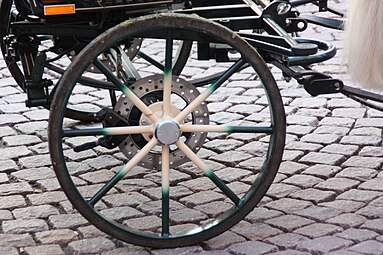
A marathon carriage is a modern metal carriage that is used for driving competitions, especially combined driving. It is named after the cross-country phase of a combined driving event which, though inaccurate, became known as the "marathon" phase. [1]: 7 The carriage is designed for safety and carries a driver plus one or two assistants, called grooms. Drivers direct the horses while grooms counterbalance the carriage on tight turns, and are available for assistance with the horses in case of an overturn or collision, or equipment malfunction.
Background
Prince Philip, Duke of Edinburgh popularized sport carriage driving in England in the 1970s, and helped standardize competition rules through the FEI. Having access to many old carriages of the royal stables, he soon discovered they were not up to the rigors of maneuvering in marathon obstacles, and several carriages were damaged or destroyed. [1]: 15, 16, 21, 39 Drivers looked to contemporary carriage makers, such as the Amish in the USA, to make sturdier wooden vehicles appropriate for sport driving, followed by more innovative designers and the invention of the all-metal carriages. In FEI driving competitions, marathon carriages are the only style of carriage allowed for the marathon portion of a combined driving competition, and are allowed in driven dressage which previously required a traditional carriage. Minimum widths and weights of the carriage are also regulated. [2]
Description
A marathon carriage is made of steel or aluminum, with non-slip surfaces and wide fenders (mud guards) because it may be travelling through water and mud during competition. They are constructed for safety with a low center of gravity, and a very small turning radius, both which help reduce the chance of overturning. A low platform for the groom at the rear allows a crouching groom to further lower the center of gravity. [3]: 46, 59 They usually include hydraulic disc brakes, suspension (either air or spring), and plenty of handholds for the grooms. [1]: 15, 52
Shafts for single-horse carriages are shortened to terminate at the harness saddle instead of reaching the horse's point of shoulder. The driver's seat is usually raised with high sides to keep the driver in position. Many teams have the groom holding a belt around the driver's hips to keep the driver secure during maneuvers, but if the carriage overturns, the driver will not be pinned as he might with a locked in seat belt. [1]: 79
Wheels have metal spokes, welded at the hub, which can tolerate sideways forces. Hubs are constructed flat; traditional wooden wheels have protruding hubs which have caused difficulties in the marathon obstacles. [1]: 8, 13 Some vehicles are designed with cambered wheels to reduce sideways sliding. [4] Marathon vehicles are constructed with horizontal guard rails (bumper bars) to deflect the carriage from posts and small trees and keep from getting caught on them. A bowed rail across the front protects the front wheels, and rails running down each side over the wheels keeps from getting a post caught between the front and rear wheels when turning sharply around a post. The open back design makes for easier, quicker and safer entry and exit of a groom, who previously entered from the side between the wheels. Looking quite different from traditional carriages, they acquired the nickname "battle wagons". [1]: 52–54, 70
Since a marathon carriage is built with the front axle pivoting on a turntable (usually called a fifth-wheel), the front wheels can rotate until one wheel is fully under the body of the carriage. During such tight turns, the carriage operates like a three-wheeled vehicle (one wheel in front), and the entire carriage can easily tip over if not careful, risking severe injury to the occupants. [3]: 1–2
- Safety features
-
High-sided seat and groom holding belt around driver's hips
-
Shortened shafts
-
Disc brakes
-
Some extreme counterbalancing on this highspeed tight turn
See also
References
- ^ a b c d e f HRH the Duke of Edinburgh (2005). 30 Years On and Off the Box Seat. J. A. Allen. ISBN 0851318983. OL 11598049M.
- ^ "FEI Driving Rules, Chapter VII Carriages and harness, Article 936 Permitted Carriages" (PDF). Fédération Équestre Internationale. January 1, 2020. pp. 25–26.
- ^ a b Binder, Christof (April 6, 2016). "Influence of human mass and posture on the rollover characteristics of carriages" (PDF). Vienna University of Technology.
-
^ "Why are carriage wheels dished?". The Carriage Journal. Vol. 58, no. 3.
Carriage Association of America. May 2020. p. 178.
High speed performance vehicles, like marathon carriages, use steel spokes welded at the hub and felloe. They can tolerate sideways forces beyond anything our horses can do so far. Some marathon vehicles have the axle tipped so that the top of the wheel is more inboard and the bottom of the wheel more outboard. This is not for strengthening the wheel. It is so that a greater part of the rim surface is in contact with the ground to reduce sliding sideways in a turn.



